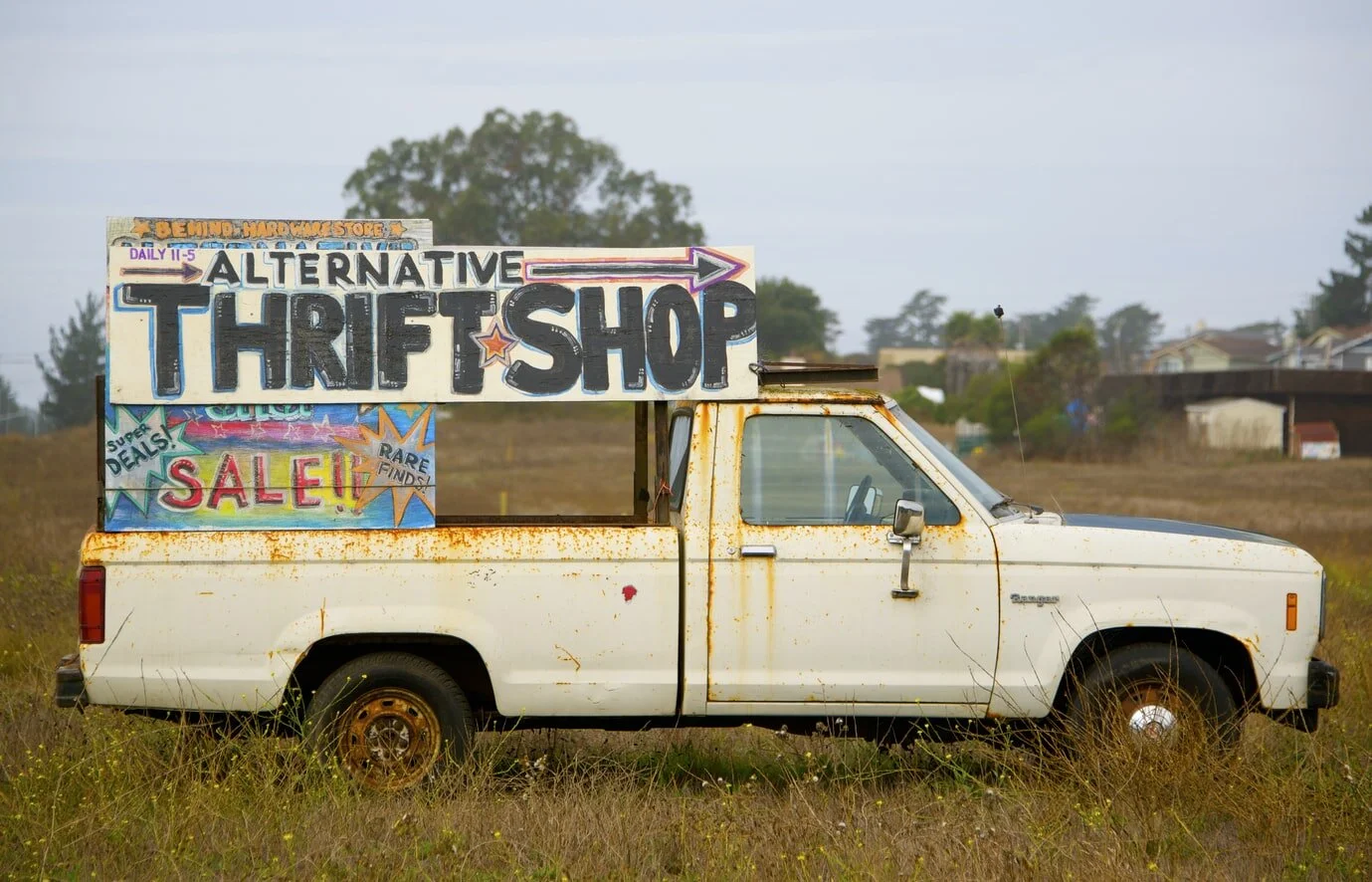By: Lyndsey Antos
“Hey, Macklemore![1] Can we go thrift shopping?”[2] A catchy rap song from almost a decade ago encouraged many young adults to ditch the Fast Fashion trend and head towards the nearest thrift store[3]. Thrift shops are considered “shop[s] that sell secondhand articles and especially clothes.” [4] These stores provide a great way to cash in on a bargain for clothing items that would typically be out of an average person’s budget.
Fast Fashion, on the other hand, “is an approach to the design, creation, and marketing of clothing fashions that emphasizes making fashion trends quickly and cheaply available to consumers.”[5] Fast Fashion appeals to the average person looking to buy a greater number of clothes at a low price.[6] People trying to stretch their dollar as far as possible with Fast Fashion should pause to consider whether it is truly the best way to spend their dollars.
The term ‘Fast Fashion’ was coined in the New York Times when the company Zara was able to bring clothes from the runway to stores in a short time.[7] Other stores, such as H&M, Forever 21, and Topshop, began to pick up on this trend, and the online market and in-store shopping for Fast Fashion took off at rapid speed.[8]
While Fast Fashion manufacturing allows clothing to be produced rapidly enough to meet consumer demands, the production process also creates a large number of chemicals and water waste.[9] Stores in the business of Fast Fashion use cheap materials such as cotton and polyester, which increases levels of plastic, requires large amounts of water to make, and results in plastic pollution in the ocean; an abundance of ocean plastic causes injury to ocean-life, and leads to the creation of other wastes such as lead, mercury, and arsenic.[10]
To explain, it takes about 2,700 liters of water to make one cotton shirt.[11] Therefore, the thousands of cotton shirts produced daily, using millions of water liters, result in an unbelievable amount of water waste. Along with this, chemicals like carbon dioxide (CO2) and other gas emissions are pushed out into the atmosphere causing environmental pollution.[12]
As implied by the name Fast Fashion, these clothes are produced at fast speeds, substantially reducing the items’ quality, which ultimately leads to many Fast Fashion items filling up landfills instead of closets. What more, when this happens, the clothing items cannot be decomposed because of the construction of the materials.[13] From the chemicals and water waste produced to manufacture the clothes to the non-decomposing materials that end up in landfills for discarding the clothes from their short use, Fast Fashion is quickly destroying our environment with one credit card swipe at a time.
However, there is a solution. Instead of rushing to the local mall to find the perfect fashion trend, the local thrift store might be the actual answer and the environment’s way of saying “thank you.”
According to Thredup, if all individuals in the United States just bought one used item instead of something new, it would be the same as 500,000 cars off the road for a whole year.[14] Thrifting allows buyers to purchase a used product instead of something new and prevents that item from going to a landfill.[15]
Buying a used piece of clothing also allows an individual to ditch the Fast Fashion trend. If more individuals buy used items, not as many Fast Fashion pieces will sell, causing less production which, will result in less water usage, less plastic in the ocean, and fewer chemicals released into the atmosphere. Some thrift stores will have environmentally friendly options at a much lower cost than buying them outright new, as well as some high-end pieces that are a lot friendlier on one’s wallet.[16]
Instead of discarding Fast Fashion items to the trash, a buyer can donate them to thrift stores.[17] Just because a piece of clothing is no longer valuable to a certain individual does not mean it has completely lost its value. Individuals can find other uses for pieces of clothing, increasing the life of the material. When you are donating your clothes, you are preventing landfills from becoming filled with non-decomposable items.
When buying used, a shopper is buying items that have not caused more water waste. These items have already been through the cycle. Thus, the buyer is allowing the clothing to have more sustainability instead of buying a new Fast Fashion item, causing the manufacturing of Fast Fashion to decrease.[18] With more individuals pursuing the thrift shop lifestyle, it will hopefully slow down the Fast Fashion trend while positively affecting our environment.
[1] Macklemore & Ryan Lewis, Thrift Shop, in The Heist (Alt. Distrib. All. 2012).
[2] Id.
[3] David Kobialka, Popping tags, PopAnth (Dec. 04, 2013), https://popanth.com/article/thrift-shopping-with-macklemore.
[4] Thrift Shop, Merriam-webster.com, https://www.merriam-webster.com/dictionary/thrift%20shop (last visited Sep. 13, 2020).
[5] Fast Fashion, Merriam-Webster.com, https://www.merriam-webster.com/dictionary/fast%20fashion (last visited Sep. 13, 2020).
[6] Solene Rauturier, What is Fast Fashion?, good for you (May 10, 2020), https://goodonyou.eco/what-is-fast-fashion/.
[7] What Is Fast Fashion? How Your Clothes Are Hurting The Planet, The Well Essentials, https://www.thewellessentials.com/blog/what-is-fast-fashion-how-your-clothes-are-hurting-the-planet (last visited Sep. 13, 2020).
[8] Rauturier,supra note 6.
[9] Kiana, Fast Fashion Facts: What you need to know, 7Billion for 7Seas (Nov. 16, 2018), https://7billionfor7seas.com/fast-fashion-facts/.
[10]What’s wrong with the fashion indus.?, Sustain Your Style, https://www.sustainyourstyle.org/en/whats-wrong-with-the-fashion-industry (last visited Sep. 13, 2020).
[11] Water & Clothing, The Conscious Club (May 15, 2019), https://www.theconsciouschallenge.org/ecologicalfootprintbibleoverview/water-clothing#:~:text=To%20produce%20just%20one%20cotton,4%25%20of%20global%20freshwater%20withdrawal.
[12] What is Fast Fashion and Why is it Bad?, mamoq (Apr. 01, 2019), https://mamoq.com/blogs/the-journal/what-is-fast-fashion-and-why-is-it-bad#:~:text=Fast%20Fashion%20is%20also%20no,make%201%20cotton%20t%2Dshirt.
[13] Tatiana Schlossberg, How Fast Fashion Is Destroying the Planet, N.Y. Times (Sep. 3, 2019), https://www.nytimes.com/2019/09/03/books/review/how-fast-fashion-is-destroying-the-planet.html.
[14] Hena Sharma & Allyssia Alleyne, How to shop for clothes responsibly, CNN style, (Sep. 2, 2020), https://www.cnn.com/style/article/guide-how-to-shop-responsibly-sept/index.html.
[15] Erich Lawson, How Does Thift Shopping Help You Save the Env’t?, Green And Prosperous (Oct. 11, 2017), http://www.greenandprosperous.com/blog/2017/10/11/how-does-thrift-shopping-help-you-save-the-environment.
[16] Thrifting: It’s More Than Just Clothes, Planet Aid (Jan. 31, 2019), https://www.planetaid.org/thrift-center/thrift-center-blog/the-thrifting-movement.
[17] Stop Throwing Away Clothes, ecopartners, http://www.ecopartnersinc.com/2018/08/21/stop-throwing-away-clothes/(last visited Sep. 14, 2020).
[18] Brianna LaSita, Commentary: Thrifting supports envtl.sustainability, THE ITHACAN (Sep. 18, 2019), https://theithacan.org/opinion/commentary-thrifting-supports-environmental-sustainability/.



